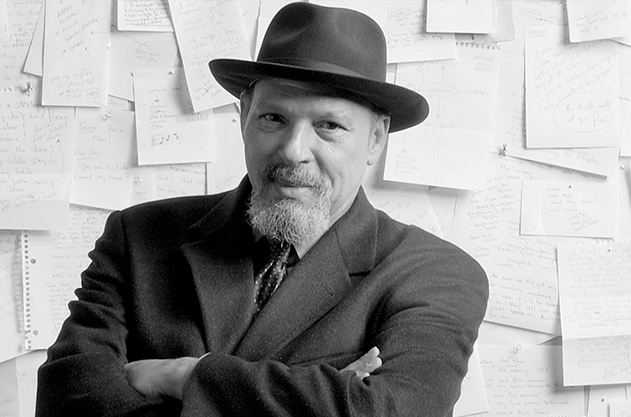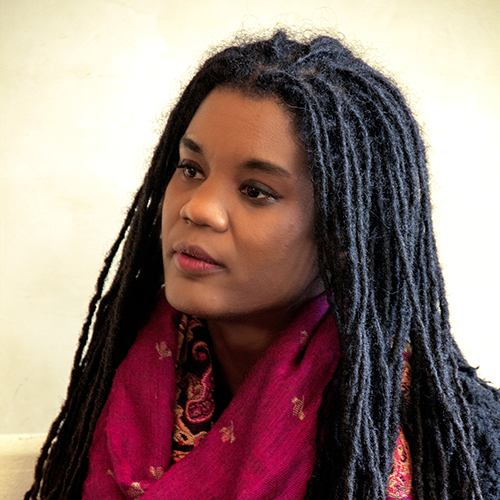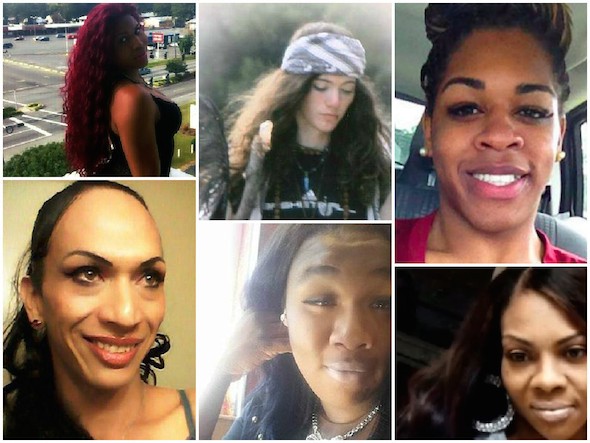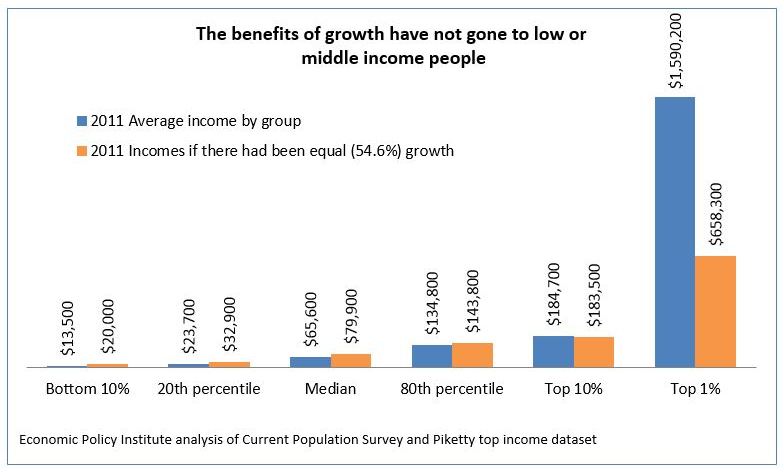available for purchase
at this time.
In The Intersection
Link Roundup! – 3/20/15
March 20, 2015Link Roundups feature articles and bits of internet goodness that our dramaturgy team digs up. If you find something you want to send our way, drop us a line on Facebook or Twitter!
♦♦♦♦♦
Melissa Hillman’s post on the TCG blog about what engagement really means gets at some important truths about connecting with audiences:
If we’re going to have productive discussions about diversity, even coded as “audience engagement,” we first need to stop pretending that there’s one discrete “theatre community” that’s all failing in the same way. We need to stop pretending that a lack of diversity in big budget theatre is a lack of diversity in “theatre,” as if people of color cannot create theatre unless a big, white theatre bends down to help them. We need to stop pretending that a lack of diversity in big budget theatre audiences is a lack of diversity in “theatre audiences,” as if young people of color have no theatre unless a big, white theatre creates a space for them. You can’t stop young people of color from making art. It’s happening everywhere, all the time. You can’t stop young people of color from consuming art. It’s happening everywhere, all the time.
♦♦♦♦♦
Over at The Nib, a cartoonist shares a story about the perception of race in comics:
BCA PlayLab: What We’re Reading
March 13, 2015The dramaturgy team will be periodically posting updates and highlights from the 2015 BCA PlayLab in the coming months. Follow along and let us know what you think on Facebook or Twitter!
♦♦♦♦♦
In the weeks following our first BCA PlayLab meeting, we’ve been collecting articles and essays pertinent to playwriting and life as a writer that we wanted to share with the group. The articles we share aren’t necessarily endorsements, but are a great jumping off point for discussion — here are a few to kick things off:
The Most Successful Creative People Constantly Say ‘No’ – Business Insider
No matter what you read, no matter what they claim, nearly all creators spend nearly all their time on the work of creation. There are few overnight successes and many up-all-night successes. Saying “no” has more creative power than ideas, insights and talent combined. No guards time, the thread from which we weave our creations. The math of time is simple: you have less than you think and need more than you know.
So the anti-resumé remains my deceptively simple answer to the question, ‘How do you do it?’: that I persisted during all those years of rejection for no other reason than that I loved writing so much I wanted to spend all my time doing it. Writing must be its own reward, even for the most talented and hardworking writers, or they’re going to have a tough time.
Link Roundup! – 3/13/15
March 13, 2015Link Roundups feature articles and bits of internet goodness that our dramaturgy team digs up. If you find something you want to send our way, drop us a line on Facebook or Twitter!
♦♦♦♦♦
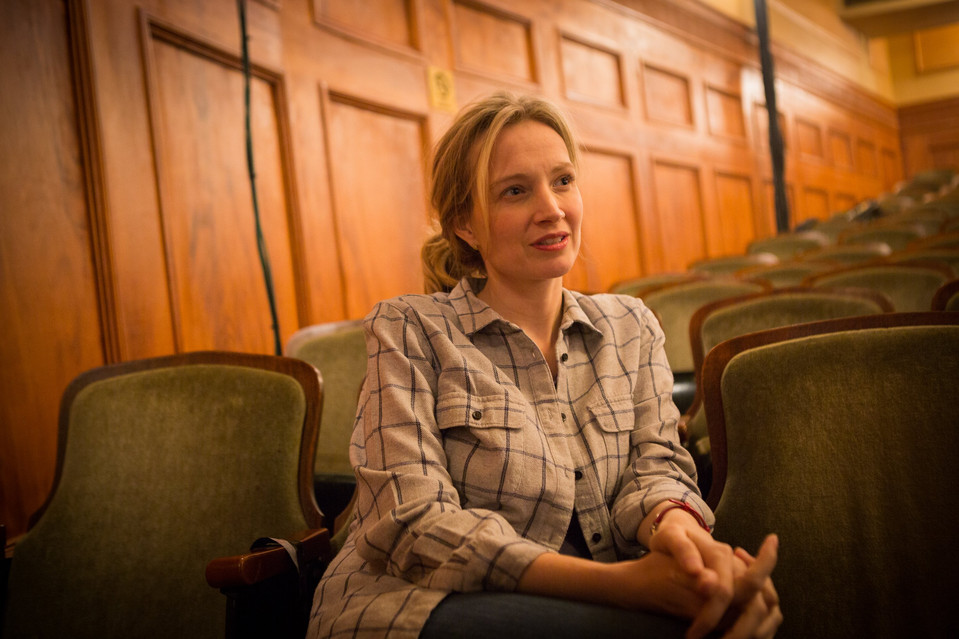
Playwright Bess Wohl at the Abrons Arts Center Playhouse. Photo: Cassandra Giraldo for The Wall Street Journal
The Wall Street Journal has an article up about playwrights who write for film and television, examining the way it allows for a more sustainable income than theatre:
In the nonprofit theater, playwrights like Ms. Wohl earn income from grants, commissions and in some cases fees from regional and international productions of their work. Only for a small handful does this accumulate to a living wage.
In TV, on the other hand, a complex system of generous minimums is in place to determine compensation for writers, whose salaries and fees vary based on a variety of factors, including a show’s length and where it is being broadcast or streamed.
♦♦♦♦♦
The Guardian takes a look at childcare and parent-friendly practices in theatre with their article “Parents in the arts need to stage a childcare revolution”:
Of course it’s not just women who are affected by such responsibilities. But perhaps one of the reasons that there are fewer female theatre directors sustaining longer-term careers is that it’s hard to juggle family and directing. Plenty of women set out to be directors, but then when children come along, it is far harder to keep going alongside caring responsibilities which still often fall primarily upon women…Maybe that explains why only 29% of directors in big theatres are female.
#StaffChat: A Critical Look at THIS IS MODERN ART
March 12, 2015Staff Chat posts feature articles and news that the C1 team discusses as part of our weekly all-staff meeting. We’d love to hear your thoughts too — hit us up on Facebook or Twitter!
♦♦♦♦♦
This week’s Staff Chat will focus on the conversation around the play This is Modern Art (Based on True Events), a Steppenwolf for Young Adults production co-written by Idris Goodwin and Kevin Coval. We’re looking at two reviews of the play and a few articles that examine the critical reception of the piece:
- — REVIEW: ‘This Is Modern Art’ at Steppenwolf Theatre By Chris Jones
- — Steppenwolf’s deeply misguided ‘This Is Modern Art’ spray paints all the wrong messages By Hedy Weiss
- — Are These Modern Reviews of ‘This Is Modern Art’? By Howard Sherman
- — Playwrights Rip Trib and Sun-Times Theater Critics Over Graffiti Play By Paul Biasco
- — CREATE a movement: the ART of a revolution By Hallie Gordon
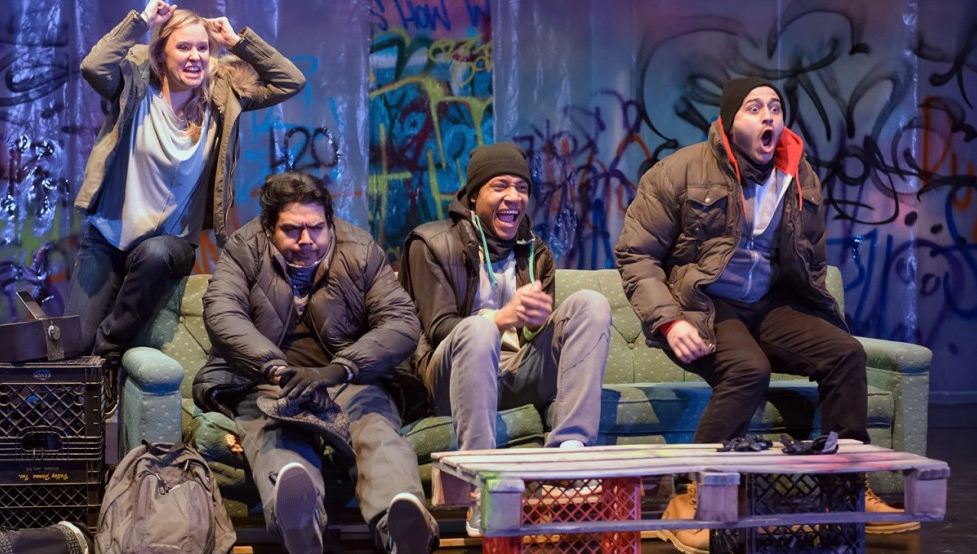
Kelly O’Sullivan (from left), J. Salome Martinez Jr., Jerry MacKinnon and Jessie D. Prez in the Steppenwolf Young Adults production of “This Is Modern Art.” (Photo: Michael Courier)
The play, inspired by a real incident, follows a group of Chicago teens who decide to cover the Art Institute of Chicago’s Modern Wing in graffiti art. In their reviews, critics Jones and Weiss briefly touch on the artistic aspects of the play (which they seem to praise), but spend most of their columns taking the show to task for its portrayal of graffiti artists. From Jones:
But here is what “This is Modern Art” barely even mentions: Graffiti comes at a price. It can be invasive, self-important and disrespectful of the property of others — and plenty of struggling folks have had to clean graffiti off something they own or love. Graffiti can be inartful, for goodness sake. More importantly yet, graffiti had the effect of making people feel unsafe in the city. It terrified people. It was only when public officials declared themselves determined to wipe it out that cities finally came back to life, with broad benefits.
You wanna go back to riding public transportation in New York or Chicago in the 1980s? I do not. You do not have to be conservative or somehow not down with youth to think it reprehensible that these issues do not have a place in a show for schools that is quite staggeringly one-sided.
Weiss continues this line of thought in her review, though she takes it even further, stating:
This play is a wildly wrong-headed and potentially damaging work — one that fails to call “vandalism” by its name, and rationalizes and attempts to justify that vandalism in the most irresponsible ways. It also trades in all the destructive, sanctimonious talk about minority teens invariably being shut out of opportunities and earmarked for prison in a way that only reinforces stereotypes and negative destinies. Counterproductive in the extreme, it deepens and solidifies racial and class divisions and a sense of hopelessness among those who need to dwell on possibility.
Link Roundup! – 3/6/15
March 6, 2015Link Roundups feature articles and bits of internet goodness that our dramaturgy team digs up. If you find something you want to send our way, drop us a line on Facebook or Twitter!
♦♦♦♦♦
An essay about August Wilson is up at The New Republic, as well as a link to the PBS American Masters documentary August Wilson: The Ground on Which I Stand, which aired recently to commemorate the 10th anniversary of Wilson’s death.
The economic hardship and systemic racism suffered by African Americans were hardly the only subjects Wilson tackled. Seven Guitars deals with black manhood. In King Hedley II, set in the 1990s, actors, such as future Oscar nominee Viola Davis, powerfully brought women’s reproductive choice into an African American arena. Wilson also delved into the paranormal in The Piano Lesson and Gem of the Ocean. In that way, the playwright perhaps helped us see aspects of our lives even we tried to erase.
♦♦♦♦♦
At The Guardian, Maddy Costa writes about the need for theatres to be less uptight about the behaviors and disruptions of their audiences, and examines how theatre culture could change if “relaxed” performances weren’t just one-off events:
A vital question was raised at the event: what might the theatre landscape look like if it were more relaxed, not occasionally, but all the time? Last summer, a Theatre Charter was proposed, detailing expected behaviour for the benefit of occasional theatregoers: no rustling sweet wrappers, no mobile phones, definitely no eating McDonald’s. How much more inviting might theatres feel if they didn’t just reject the snobbery embedded in such a charter, but offered a different manifesto, in which it was clear that all people – whatever their backgrounds, ages, physical or mental abilities – were welcome to see any performance, any day they wanted, together?
Link Roundup! – 2/27/15
February 27, 2015Link Roundups feature articles and bits of internet goodness that our dramaturgy team digs up. If you find something you want to send our way, drop us a line on Facebook or Twitter!
♦♦♦♦♦
Playwright Chisa Hutchinson, who recently received a Dramatist Guild award for early career playwriting, has an interview on The Interval about the development of her work and the representation of women and non-white writing in the theatre:
Q: How do you think theater can better address race?
A: To give room to everyone. It’s hard for me to listen to people who literally cannot imagine the experiences of other people and therefore dismiss those experiences like, “No, of course that doesn’t happen. This is post-racial America.” Can we just make room for other experiences? Or just acknowledge that there are experiences different than yours?
♦♦♦♦♦
It’s Native voices week on HowlRound and the site is featuring essays from various Native American artists, including this thoughtful piece by Larissa FastHorse:
Do white playwrights ever think about this? Do they worry about losing jobs for white actors? Do they question if they are writing about enough white issues? Are they expected to be the voice of all white people even when they are just speaking for themselves? Do they fear their play about a girl who wants to be a ballet dancer is responsible for the genocide of their race?
Link Rounup! – 2/20/15
February 20, 2015Link Roundups feature articles and bits of internet goodness that our dramaturgy team digs up. If you find something you want to send our way, drop us a line on Facebook or Twitter!
♦♦♦♦♦
Janet Mock, writer and Host of MSNBC’s “So POPular!”, recently wrote a moving essay about the trans women of color who have been murdered so far this year:
Personally, I know that my visibility has to be more than just about my own pursuits. When I walk into a space, I am cognizant of the fact that I am bringing communities of people with me, communities that have historically been exiled and silenced. The weight of that responsibility never lightens, even as I navigate uncharted terrain as a TV host. My show So POPular! explores the intersection of popular culture, representation, politics, identity and community. Though it doesn’t explicitly cover trans issues, it’s a space created and fronted by a trans woman of color, so the lens to which I explore topics on my show is that of a trans person, a black person, a woman of color. My goal is to take the focus away from myself as a subject, and instead be the person asking the questions, shaping the conversation.
I’ve seen folks juxtapose the recent media visibility of trans women of color and these recent murders. I’ve read sentences to the effect of: “At a time when trans women of color have visibility, we still see trans women murdered.” I find this logic to be quite basic.
Yes, trans women are being murdered. Yes, trans women of color have gained mainstream visibility. But trans women, particularly those of color, have always been targeted with violence. The differences now? There are some systems in place that better report violence and there is finally visibility of a select few that helps challenge the media’s framing of these women’s lives.
♦♦♦♦♦
In advance of this weekend’s Academy Award broadcast, The Hairpin featured a roundtable conversation about this year’s lack of diversity in the pool of nominees and whether the Oscar’s matter in 2015:
As for the role Oscars play in our lives? Aside from giving us an excuse to drink wine on a Sunday night and joke with our friends? I definitely agree with it seeping into our everyday lives, even if we don’t realize. We are aware of what movies/actors/directors win even if we don’t watch the ceremony. It’s impossible to ignore. But more importantly: Yes, representation is vital. You may not care about the Oscars or think it matters but when you’re a minority and someone who looks like you wins? That means something. That means everything — especially to this film nerd who was often surrounded by way too many white dudes in film classes. I’m reminded of the pilot episode of Black-ish when Andre is up for a promotion and narrates that, because there are so few black people at his company, when he wins and moves up the ladder, it’s like every black person at the company wins. When a woman or a person of color wins an Oscar, I feel like I’ve won, too.
#StaffChat: Poverty in Boston
February 20, 2015Staff chat posts feature articles and news that the C1 team discusses as part of our weekly all-staff meeting. We’d love to hear your thoughts too — hit us up on Facebook or Twitter!
♦♦♦♦♦
For this week’s Staff Chat, we are looking at the state of poverty in Boston in response to a report released in November:
- — Poverty Rate in Mass. highest since 1960
- — From Poverty to Opportunity: The Challenge of Building a Great Society
- — Poverty and Inequality in Massachusetts Today
The report by the Massachusetts Budget and Policy Center shows that the poverty rate in Massachusetts is at 12%, making it one of the highest in the United States. Massachusetts also leads the nation in income disparity between the lowest and highest levels of wage earners.
The Boston Globe, which broke the story, highlighted some troubling statistics, including:
- — After an initial decrease in poverty after President Lyndon Johnson declared “War on Poverty” with an army of Great Society social programs, the poverty rate slowly rose again and the current poverty rate is the same as it was in 1960
- — Though several Great Society programs (food stamps/SNAP, Head Start, Medicare and Medicaid) are still going strong, in the past twenty years Massachusetts has slashed almost $3 billion in funding for affordable housing initiatives, early childhood learning programs, and job training for young people
- — Wage stagnation is a chief cause of the plateauing poverty rate; had income growth reflected productivity growth, the lowest wage earners would be earning at least $10,000 more per year than they are now. The highest 1% of wage earners would collectively earn almost $1 million less
- — Looking solely at cash income, poverty in Massachusetts is at 27%; adjusted according to the Supplemental Poverty Measure, which takes into account other forms of income and public assistance, the poverty rate drops to 12-14%
- — Adjusted for inflation, the average working class individual earns $5000 less than his 1960s counterpart
The MBPC report included this infographic to explain how today’s worker would fare had wages increased at the same rate as productivity:
Both the report and the Globe stories point out that many of the Great Society programs are still in place and still yielding results. What sticks out in their assessments of poverty today is the idea that the best way to close the poverty gap in Massachusetts is to strengthen community bonds that will prepare future generations to succeed in all aspects of life – economically and creatively – by developing technical skills through job-based training, achieving more in school, and developing close partnerships with employers and community organizations that can provide support throughout their lives. (more…)
Link Roundup! – 2/13/15
February 13, 2015Link Roundups feature articles and bits of internet goodness that our dramaturgy team digs up. If you find something you want to send our way, drop us a line on Facebook or Twitter!
♦♦♦♦♦
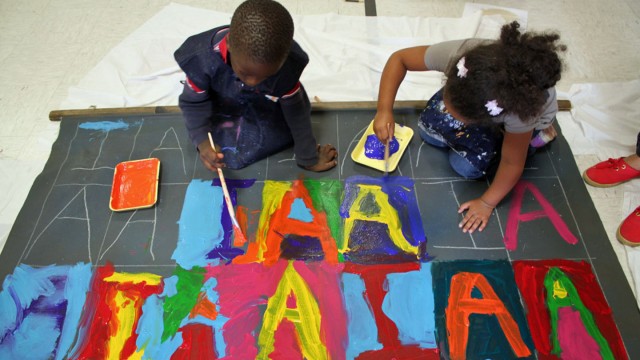
Kindergartners at Wheeler paint the backdrop for their school photos. (Courtesy of Ada Leaphart/Integrated Arts Academy at H.O. Wheeler)
This piece about the Integrated Arts Academy in Vermont combining the arts with math, science, social studies and other curriculum really highlights the importance of creativity in the classroom:
What does art integration look like? Recently, a fourth-grade lesson on geometry examined the work of the famous Russian artist Wassily Kandinsky. The class talked about his work and then created their own art using angles in the style of Kandinsky. Students had to be able to identify the angles they’d used and point them out in their art.
“Higher analytical thinking and reasoning and student voice fit so well with the arts,” said Bobby Riley, the school’s principal. Teachers are seeing ways to make connections between subjects and watch as students find creative confidence and voice in their expression.
♦♦♦♦♦
The Boston Globe has an interview with Julie Burros, the new arts and culture chief, about her plans for Boston and what she’s learned about the city’s cultural scene since taking office:
On the relationship between the arts and income inequality, I’m curious to know: Can you use arts and culture to address that growing problem?
Maximizing people’s creative capital could help create income opportunities for people who maybe don’t see themselves fitting into the four-year college track or the corporate world. There’s another relationship in, how can unlocking people’s creative tools help them be more employable, more well-rounded employees for all different kinds of industries? And then there’s just the appeal factor. If we have more robust arts and culture offerings in our schools, it could keep kids in school longer.
Link Roundup! – 2/6/15
February 6, 2015Link Roundups feature articles and bits of internet goodness that our dramaturgy team digs up. If you find something you want to send our way, drop us a line on Facebook or Twitter!
♦♦♦♦♦
Over at HowlRound, Yvette Heyliger wrote a post about her petition calling for new legislation mandating that nonprofit arts organizations and institutions receiving tax-payer dollars must allocate an equitable portion of that funding to women artists:
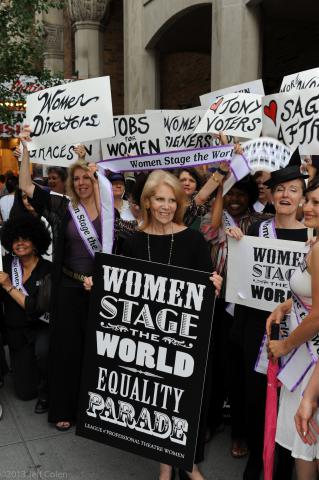
The 2013 Women Stage the World Parade in Manhattan’s Theatre District. Photo by Jeff Colen Photography.
This petition is one way to create a seat at the table of artistic opportunity. In 2015, women continue to find themselves at the children’s table, sitting on chairs too small, eating from mix-matched dishes and drinking from plastic cups. The petition is simple and straightforward. With only initials and perhaps states as identifying markers, all are welcome to sign. If the petition receives 100,000 signatures by February 6, 2015, an official response from the White House will be issued.
♦♦♦♦♦
Playwright Marcus Gardley has a great interview on the Art Works blog about his creative process and the way he views playwriting as social activism:
GARDLEY: I consider myself an activist, and I couldn’t do it if I wasn’t hoping that the work would somehow spark a dialogue, or somehow cause people to look at social issues differently. What I intend for [the plays] to do, is cause conversation afterward. From that conversation, [I hope] people are not only inspired to see more theater, but also inspired to do things in their community, so that the work is actually, literally causing a spark for change.


